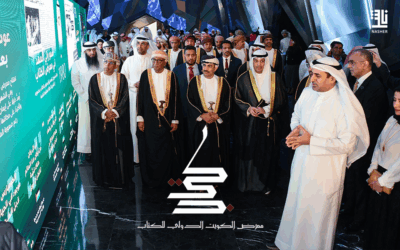Ancient Arabic texts demonstrating different styles of Arabic script form part of a new exhibition at the British Library in London on the art of writing. A 17th century illustrated Iranian Qur’an is written in the right-angled naskh for the Arabic text and in the slanted nasta’liq for the Persian translation. There is also a 16th century manuscript copied for the Mughal Emperor Akbar, while the curators believe another display would appeal to President Trump, because it illustrates what they call ‘the art of the deal’.
This is a letter written in 1871 by Jeremiah Shamer, a book merchant in Mosul, Syria, concerning the sale of some religious books in Arabic and Modern Assyrian. The curators note that the letter is written in riq’a, a form of Arabic that requires minimal lifting of the hand – useful when time is of the essence in securing a deal.
Other fascinating exhibits include the quill pen used by Alfred Lord Tennyson, James Joyce’s scrawled hand-written notes for Ulysses and the famous notebook of Robert Falcon Scott containing the words – still just legible – ‘for God’s sake look after our people’, written in 1912 at the end of his ill-fated expedition to the South Pole.
From carved stone inscriptions, medieval manuscripts and early printed works to beautiful calligraphy, iconic fonts and emojis, Writing: Making Your Mark deconstructs the act of writing and consider its future in the digital age.
Beginning with the origins of writing in Mesopotamia, Egypt, China and the Americas, the exhibition charts the evolution of writing through technology and innovation, exploring more than 40 different writing systems, from the 5,000 year old Jemdet Nasr (now Iraq) clay tablet with its very early cuneiform to digital typefaces and emojis.
One section displays an ancient wax tablet with an Egyptian schoolchild’s Greek homework from 100-199AD. There is also the diary of the Crimean War nurse and founder of modern nursing Florence Nightingale, alongside a 10th-century psalter and a 60,000-strong petition from 1905 protesting against the first partition of Bengal. Writing: Making Your Mark highlights how writing can be personal, functional, beautiful or political and challenges our preconceptions of what writing is through examples of writing as art, expression and instruction.
The last room offers visitors the chance to say what they think the future of writing will be. ‘It’s such a beautiful thing to put pen to paper and I think people will always go back to that’, writes one. Another says: ‘Writing will always be a more considered and longer lasting form of communication.’
Someone has also simply added: ‘All the power is still in the hand.’
The exhibition runs until 27 August 2019.







